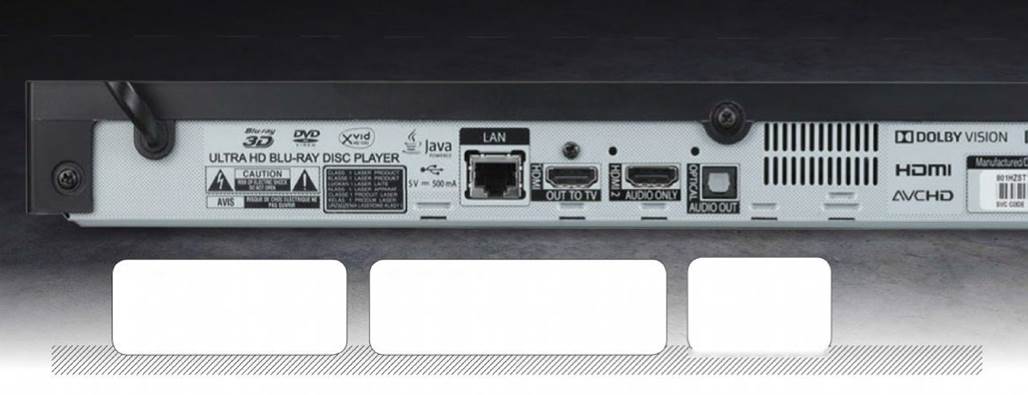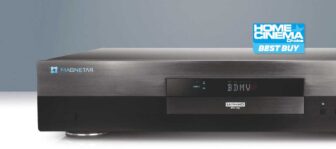LG UBK90 Review
Straight spinner
LG’s UHD Blu-ray player proves a solid video performer, though it lacks some audio options available on higher-priced spinners.
SUMMARY
LG UBK90
+ Excellent performance with quality discs
+ Good value for money
+ Good support for older AV receivers
– Limited settings available
The other big Korean may be exiting the Blu-ray player market (see the intro article), but LG is still here. Currently the brand sells two regular Blu-ray players and two UHD ones. The LG UBK90 is the premium model. The main differences compared to the UBK80 are the inclusion of Dolby Vision support, plus Wi-Fi, access to Netflix and YouTube, and a second HDMI output socket.
Equipment
Physically, the LG UBK90 is plain-looking. But I thought it plain in just the right way — all black and almost featureless. The tray is marked with the UHD Blu-ray logo and there are four small push buttons on the front, along with a USB port and one small LED. The black finish is matte (the monolith from ‘2001’, but on its side). Minimalism works.
You will note from that brief description that I didn’t mention a front display. That’s because there is none. You use the on-screen display for all interaction with the unit.
On the rear are those two HDMI outputs, so the player should work well for those who have a pre-UHD home theatre receiver. There’s also optical digital out as a last resort. There are no analogue outputs of any kind. Network connection is via 100BASE-T Ethernet or dual-band Wi-Fi.
A fast network connection isn’t really required because network support is limited to streaming from Netflix and YouTube. There’s no DLNA, let alone rendering of local network content. The only non-disc media supported is a wide range of content on USB.
Also at the back is a fixed power cable. At 2.6kg the player is a little heavier than many, and felt well-built. The disc tray opened smoothly and fairly quietly. The unit supports CD, DVD, Blu-ray and UHD Blu-ray playback only. It also works with Blu-ray 3D (though I couldn’t confirm, since these days I lack a 3D TV).
A mid-sized IR remote comes with the unit. It has most of the commonly used keys readily accessible. There is a key called ‘Info/Menu’ which you use to bring up a player menu during disc playback. The main purpose of this is to allow you to change subtitles, audio tracks, angles and so on, and to jump around to different times or chapters. Unusually, the remote control is powered by a single AAA battery.
Performance
Once I installed the system I had a quick look through the set-up menu. It offered a relatively streamlined set of options, without anything like the level of control of the far more expensive Panasonic in the following review. There were some oddities. For example, in my system it was only possible to set the output resolution to Auto or 2160p. It had 576p, 720p, 1080i and 1080p greyed out and unable to be selected. You can switch HDMI colour between YCbCr and RGB, but not choose the colour resolution (eg. 4:4:4). Presumably the player and TV negotiate that between themselves.
The audio settings defaulted to 48kHz output. In other words, higher resolution audio will be downsampled to 48kHz. If you’re using an AV receiver, you’ll probably want to change that to 192kHz or 96kHz. If using a TV for sound, 48kHz is appropriate.
If you’re not using a TV, then also consider switching DRC (Dynamic Range Control) from the default Auto to Off.
Leaving it on Auto will reduce the dynamic range of some Dolby-encoded material, using embedded metadata to guide it. The results are generally unimpressive.
The last thing in audio is a limited range of options for digital output. The default is Auto, which means the player will bitstream whatever standards the connected device says it can accept. But you can also force it to PCM multichannel or to DTS Re-Encode. This last converts all formats to DTS, which means it can be used for surround sound with any AV receiver all the way back to the early 2000s connected via optical out.
When it came to playing reference discs — UltraHD Blu-ray, or regular 1080p/24 Blu-ray — the LG UBK90 player did a first class job. At this level all one can do in a review is hope to find some performance deficiency. There were none I could identify. My LG OLED TV reported the correct reception of content from the disc, from BT.2020 colour through HDR to Dolby Vision. The picture quality seemed indistinguishable from that produced by the four-times-as-expensive Panasonic unit. That player really came into its own when dealing with less than perfect discs.
With those, continuing the theme, this player offered few options. There are no settings or choices for progressive-scan
“When it comes to playing UHD, Blu-ray and DVD content, it does its job very nicely for the most part, and with quality discs as well as any player…”
conversion; the signal will be output at whatever resolution the player and TV determine between themselves. These days that will typically be 2160p. Neither can you choose film or video-mode deinterlacing. The unit is automatic, using picture information to determine whether it thinks the video is film or video-sourced. Fortunately its thinking on the matter was pretty clear with a lot of material.
With my 576i/50 torture tests, the unit slipped up for one fraction of a second at one troublesome point, presenting film-sourced content with video-appropriate deinterlacing. That’s much better than average, and significantly better than most TVs can manage. As always, I’d prefer to be able to control this, but I can accept that inability since the player will almost never make a mistake.
It wasn’t quite as good, though, with 1080i/50 Blu-ray discs. On my difficult clips it failed in two brief sections. One was where many other devices get confused. The other was an instant which most manage successfully. Nonetheless, the overall performance was acceptable. The problem is that one is locked into relying on this player’s conversion, given the inability to set the output resolution to 1080i. You can have the best external deinterlacer in the world, and it seems that you won’t be able to use it.
The player performed snappily, loading discs promptly and switching on quickly. It offers five fast-forwards speeds and five fast- reverse speeds. There are four slow-forwards speeds plus single frame stepping, but no slow reverse nor reverse stepping.
While there’s no local network streaming or DLNA support, the player does offer playback of music, video and photos from USB. The music support includes FLAC, AAC, AIFF and WAV to 192kHz sampling, plus on the lossy front Ogg Vorbis, MP3,
AAC and WMA. Even though this wasn’t mentioned in the manual, the unit also played 44.1kHz and 96kHz ALAC test files.
The USB video worked at full resolution, including 4:4:4 colour resolution, with my test pattern, but the photo player clearly bottlenecked the resolution down to 1080p.
Conclusion
Clearly, the LG UBK90 is not for those wanting a disc player and network media device all in one unit. But when it comes to playing UHD, Blu-ray and DVD content, it does its job very nicely for the most part, and with quality discs as well as any player I’ve seen. — Stephen Dawson
Tested with firmware: BD.39338.80329.C/ UP17SON0017
Outputs: 2x HDMI, 1 x optical digital audio Others: 1 x USB, 1 x Ethernet, WiFi Dimensions (whd): 430 x 46 x 211mm Weight: 2.6 kilograms Contact: LG Electronics Telephone: 1300 54 22 73 Web: www.lg.com.au

Networking
There’s dual-band Wi-Fi and 100Mbps Ethernet — a faster connection isn’t really needed given the minimal networking functions on the LG.
HDMI outputs
Despite the price, LG’s UHD Blu-ray player still includes a second HDMI output, clearly marked ‘audio only’. This allows sound to be processed by older receivers which lack 4K HDMI connections.
Optical out
Optical out proves a further fall-back solution for older connected equipment.







